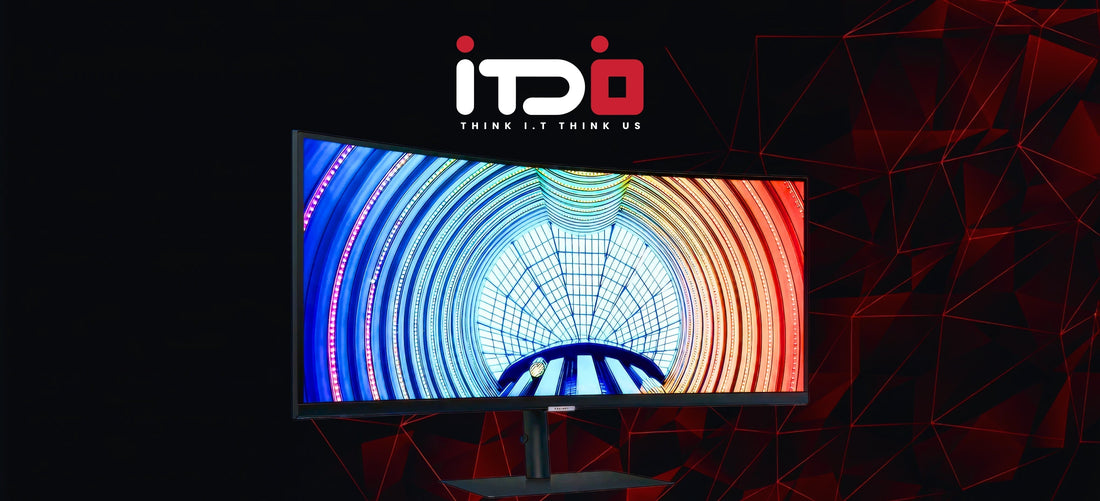
Why Gamers & Creators Love DCR Monitors (And You Might Too!)
Share
The meaning of DCR monitor is another specification that has made buyers become confused when shopping for monitors. The abbreviation of dynamic contrast ratio is known as DCR, which is used to enhance the viewing of images on a screen by automatically changing the brightness and contrast. Understanding this concept, along with related terms like native contrast ratio, static contrast ratio, and monitor settings, is essential if you want to make an informed decision when purchasing a new display. In this blog, we'll explore how DCR technology works, why manufacturers use it, its impact on image quality, and when you should enable or disable it for the best visual experience. We will also assess DCR in comparison to other display technologies and give some tips when selecting a display monitor.
Dynamic contrast, also called dynamic contrast ratio DCR is a quality available to a display that dynamically raises or lowers the brightness and contrast of images based on the input or type of content. Contrary to a fixed contrast ratio, which compares the darkest black and the brightest white, in the case of a fixed backlight, DCR varies settings in real time in order to exhibit bright scenes or unveil detail in dark ones. Basically, DCR attempts to darken dark regions and lighten bright ones to create darker blacks, warmer and closer tones, as well as a more pleasing picture, generally speaking.
What Is Dynamic Contrast?

Dynamic contrast (also known as dynamic contrast ratio DCR) is the characteristic of a display to dynamically adjust or change the brightness levels and/or the contrast levels based on the input source or type of content. In contrast to a static contrast ratio, which uses the distinction between the darkest black color and the brightest white, whether in a fixed situation like a fixed backlight, it varies the settings in response to changing scenes in order to emphasize bright scenes or to emphasize detail in dark scenes.
Basically, DCR is an attempt to pin darker areas darker, and brighter areas brighter, and achieve deeper blacks, vibrant colors, and present in general a more visually appealing picture.
Static vs. Dynamic Contrast Ratio
There are three major terms that you have to differentiate in order to find out just what DCR means:
Static contrast ratio - This represents the absolute difference between the darkest black and the brightest white that a monitor is capable of creating under constant light. It shows the real prowess of the display.
Native contrast ratio - This is almost similar to the static contrast; however, it is used to determine the monitor's ability without further adjustments. A higher native contrast ratio usually means better picture quality.
Dynamic contrast ratio - This is a value obtained when the monitor applies DCR technology to adjust the backlight intensity and monitor settings the monitor uses on a case-by-case basis in the current frame to cause an artificially inflated contrast ratio.
Most brands claim a higher DCR value, and one must realize that a higher native contrast ratio tends to indicate actual image quality and that DCR is more of a marketing and enhancement tool.
How DCR Technology Works

At its core, dcr technology relies on the display’s ability to dynamically adjust backlight brightness. An example of this is when you are viewing a dark movie and the monitor reduces the brightness and backlight that forms even blacker blacks. As the scene changes to a sunlit landscape, the backlight intensity becomes large in order to accentuate bright colors and details.
Some high-end monitors use local dimming, dividing the backlight into multiple zones that adjust independently. This creates a better contrast and color accuracy as opposed to older LCDs, which would simply turn down the whole screen at a time.
Advanced DCR monitors also apply image processing, such as gamma correction, color temperature control, and dynamic control to varying brightness. Together, these build to a major enhancement of the overall image quality in comparison with the displays that use pure factory settings.
The Impact of DCR on Image Quality

The goal of DCR is to enhance contrast and boost image quality. This way, it enhances bright and dark areas, and it is used to make vivid colors more vivid without over splicing dark areas.
For everyday use, this results in:
-
Richer blacks in movies with dark scenes
-
Sharper visibility in games with fast-changing lighting
-
More appealing photos and videos
Nevertheless, DCR is not always exemplary. As it depends on dynamic adjustments, minor delays are present in changing the contrast levels, which could lead to input lag in high-paced games. Also, the appearance of the image dynamically adjusted by the system does not appeal to all users, particularly over an extended period of usage, because it causes eye strain.
DCR and Professional Work

In case you do the video editing or photo editing using your monitor, you may like the idea of having DCR turned off. Although this has been proven to make movies and games more interesting, the consistency of color accuracy and color depth is, in most cases, preferred by professionals.
As an illustration, in cases where you are tuning the shadows of a dark image, a monitor that is actively adjusting the brightness control may prevent a person from distinguishing the actual color. Professionals instead use the native contrast ratio and static contrast of monitors, and display settings properly calibrated.
With that said, there are also users who like the dcr feature even when in casual use, because it is capable of recalibrating fine-tune settings of the monitor without having to location hunt through the OSD menu.
Advantages and Limitations of DCR
Advantages:
-
Creates deeper blacks and sharper highlights
-
Produces more vibrant colors
-
Offers better contrast in bright scenes and dark scenes
-
Can be enabled easily in the OSD menu
-
Helps movies and games appear more appealing
Limitations:
-
May reduce color accuracy for editing work
-
Artificially inflates contrast ratio numbers compared to the native contrast ratio
-
Can introduce input lag
-
Not always ideal for extended periods due to eye strain
-
Monitor depends on content type—cartoons or movies look great, but text documents may not benefit
When to Enable DCR
Is DCR good for you depends on usage. Watch movies, play games, or look through content-rich content at the eye, you will probably like the overall contrast boost. The capability to enable DCR would provide a significant improvement to your visual experience, particularly with dark scenes or quicker variations in brightness levels.
However, when your activity needs accurate color reproduction, as is the case with design, video editing, and photo editing, use the native contrast ratio that your monitor is built with and use the contrast settings yourself.
The Role of DCR in Gaming

Gamers usually give importance to graphics card performance, refresh rate, and response time. Although DCR has no direct impact on them, it does affect the way the darkest black shade, the brightest white shade, and bright colors look in gameplay.
A fixed relative native contrast ratio may be desirable in management to ensure that there is no input lag in competitive gaming. The dynamic contrast in the case of immersive RPGs or movies, though, positively affects the overall picture quality by building dark areas that become more realistic.
The promotion of modern display models usually focuses on the idea of dynamic contrast ratio, so that it displays its applicability to the bright and dark areas. Local dimming allows a DCR monitor to dynamically adjust its backlights in multiple zones, allowing it to enhance contrast and improve the display of movies and games. The combination of the dynamic contrast ratio DCR technology and the optimized contrast levels makes the performance remain smoother and at the same time provides the detail to the darker frames. Their balance of dynamic contrast ratio and fast response time, and the effect of refresh rate to offer fluid movement, is what gamers appreciate the most.
In real-life applications, a DCR monitor, which has been designed to support dynamic contrast ratio, will generally employ sensors to locate ambient light and therefore dynamically adjust brightness. Monitors can be used with more natural images through the combination of local dimming and dynamic contrast ratio DCR to further enhance contrast both in the bright and dark areas. The contrast, a clear, consistent response time of reaction, and a steady refresh rate combine to provide a clearer picture to the viewers. Finally, the successive evolution of dynamic contrast ratio enables the display to achieve more classifying experiences without affecting performance.
High Dynamic Range vs. Dynamic Contrast
There are users who use the high dynamic range (HDR) interchangeably with the dynamic contrast ratio. HDR is another technology that is independent and uses contrast levels, color depth, and brightness levels to create real-life images. HDR content is mastered unlike DCR, with more data of bright areas of the picture and dark scenes, which the monitor replicates, should it be HDR-compatible.
The two are intended to provide better contrast and richer colors, though HDR tends to be superior with the available support. Anyway, even LCD displays that lack HDR can be used to reproduce similar effects at a cost-effective price, provided they use DCR.
Choosing the Right Monitor

When comparing monitors, don’t be swayed by just a higher DCR value. Pay attention to:
-
Native contrast ratio (for true performance)
-
Static contrast ratio (to understand the base level)
-
Support for local dimming and HDR
-
Adjustable display settings for fine-tune control
-
Features like low contrast mode or reduced power consumption
If you’re shopping for a modern monitor with excellent image quality and wide screen space, check out the Samsung S34A654UBN ViewFinity S65UA 34" Ultra-Wide Curved Monitor. It offers excellent contrast, strong color accuracy, and flexible monitor settings, making it suitable for both entertainment and productivity.
Practical Tips
-
Always consult your monitor’s manual to see how to enable DCR and adjust display settings.
-
Experiment with the OSD menu—sometimes factory defaults are not optimized.
-
If you experience eye strain, reduce overall brightness or disable DCR for extended periods.
-
Pairing with a good graphics card can further improve overall image quality and reduce input lag.
Conclusion
dcr stands for dynamic contrast ratio, which is necessary and enables the consumer to make sense out of the marketing claims and used performance. Although there is increased enthusiasm associated with a higher DCR when it comes to rendering movies, games, and casual uses on it, professionals tend to be calmed down to the native contrast ratio and proper monitor settings.
You either have to use or not use the dcr feature at the end of the day, according to your needs. The effects of dynamic contrast in the cinematic experience are vibrant colors, deeper blacks in the movie, and a better visual experience as a result. When precision work is to be done, use calibrated settings along with accurate color reproductions with the use of the static contrast.
Through the interaction of DCR technology with contrast ratio, color accuracy, and image quality, you will also be in a better position to select a monitor that is more efficient, easy to use, and provides the overall picture quality.
